Ellesmere Manuscript of Chaucer’s Canterbury Tales
By: Lindy Giusta
San Jose State University
Professor Elizabeth Wrenn-Estes
April 26th, 2011
Introduction
Chaucer’s Ellesmere manuscript was produced somwhere between 1400 and 1405 after Chaucer’s death. The Ellesmere is said to be the most beautifully decorated and most complete version. Not only were the decorations outstanding but the timeless story of the twenty-two pilgrims on their journey as they share is still read in English classes today.
About the Author and Setting
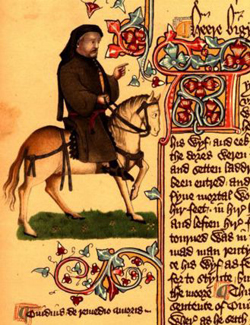
Figure 1 - Chaucer Ellesmere
Geoffrey Chaucer was born in London around 1343 to a wealthy family with connections to the crown. During Edward III’s reign Chaucer held a variety of positions including diplomat, bureaucrat, and court poet. He made many trips abroad and became familiar with poets and writers from other countries from whom he was influenced. He wrote a variety of poems for the court but is main known for his collection of tales in poetic form known as the Canterbury Tales. Chaucer was well-known for his use of metrics and his satirical twists. He wrote the Canterbury Tales towards the end of his career and it is about a pilgrimage of various people telling tales along the way (Ackroyd, 2004). He died in 1400 in South Westminster Abbey which is now known as the Poet’s Corner. He is considered to be the most important English author prior to Shakespeare.
During Chaucer’s time there was a lot of unrest in England and in Europe in general. As a diplomat, Chaucer was affected by the Great Schism between the Pope’s in Italy. Life was also chaotic in England with the Peasant’s Revolt and the Hundred Year War. The Peasant’s Revolt was due primarily to the unfair taxes bestowed upon poor citizens. The wages were also unfair for the working class which resulted in an uprise of violence. Chaucer was the exact type of person the peasants were opposed to, and it is noted that he most likely went into hiding at the time (Ackroyd, 2004, pg. 99).
Content
The general premise of the Canterbury Tales is a religious pilgrimage from London to a town in England called Canterbury, to visit the shrine of St. Thomas Becket. The group making this pilgrimage consists of various random people such as a friar, a nun, a knight, and a host. They play an interesting game where each member tells two tales and the one who tells the best tale wins a free meal. However, we do not get to see who won the game since the Canterbury Tales was meant to be 120 tales but ended up being only 24. It is likely that Chaucer got distracted or did not have the time to finish it. The intended order of the Tales is unknown and is therefore an educated guess. The tales have a religious undertone but are met with stories regarding things like affairs, etc… Such contradictions were common with Chaucer since he himself was a contradiction between religious piety and human desires.
Scribe
There is but one scribe who is thought to be associated with the Hengwart and Ellesmere Manuscript. The scribe is named Adam Pinkhurst. The script written in an “English vernacular bookhand”. The scribe is considered to be very skilled but would sharpen the quill or quit for the day in the middle of the project which resulted in different sizes of letters, and shades of ink. (Schulz, 1966). The Hengwart has fewer errors than the Ellesmere but is missing the Canon Yeoman’s Prologue as well as its corresponding tale. The Ellesmere is more complete, congruent and has more in-depth illumination. An interesting fact is that the scribe of both the Hengwart and Ellesmere left blank pages in the manuscript most likely in case the incomplete tales of the Squire and Cook, were to be discovered. (Schulz, 1966).
Illumination
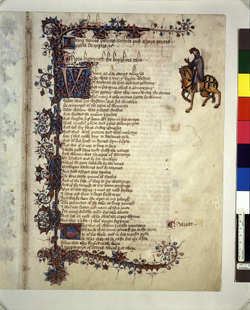
Figure 2 - Illumination Knight
Overall, the Ellesmere manuscript is the most heavily decorated of all the other Canterbury manuscripts. This can be seen with the three-quarter borders also known as demi-vinets. These decorations are on more than seventy-ones pages of the manuscript which makes it one of the most extravagantly decorated manuscripts of its time. The borders are usually decorated with leaves, and floral type decorations, weaving themselves into a beautiful border. Not only are there lavish border decorations but there are up to twenty-five paragraph breaks on a single page which aid in adding light to the page. The text was added prior to the decorations and the decorations themselves were sketched out before the color was applied. (See Figure 2) (Schulz, 1999, pg. 36)
The accompanying initials were heavily decorated as well. There were roughly 225 initials which were large and decorated in gold and other colors. They usually measured between two and six lines in length. (Schulz, 1999, pg. 36).
Pilgrim Miniatures
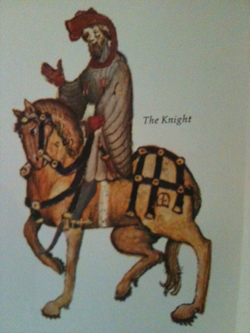
Figure 3 - Knight Illustration
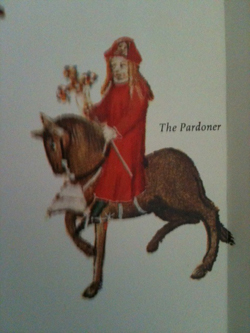
Figure 4 - Pardoner Portrait
Another noteworthy mention is the twenty-three pilgrim images that the manuscript displays. Once the writing was complete, the artists would illustrate the pilgrims which have come to be known as the “miniatures”. The artists must have been very familiar with the stories since the miniatures were very reflective of the text. The pilgrim known as The Miller for example was depicted with a bagpipe which was akin to the story of him blowing it as they left London. All the pilgrims were placed on horses. It is assumed that there were most likely three artists involved in the Manuscript since there are varying levels of skill and style.(See Figure 3 & 4)
The famous portrait of Chaucer is done by one artist while the portraits of the pilgrims with their horses walking on grass are done by another artist, and it is thought that one or two artists did the rest of the eighteen. (Thrope,1974, p.10)
Ink & Binding
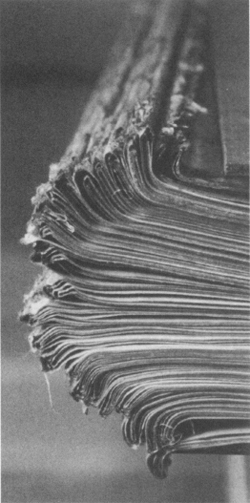
Figure 5 - Quires

Figure 6 - Binding
The Manuscript is the largest version strictly holding the Tales and measures 15 ¾ inches with a width of 11 1/8 inches with 232 leaf pages.
With careful observation after the rebinding which took place in 1991(See Figure 6) it was determined that the ink used in the text is an organic brown while the ruling is stained pink which is caused by the organic red pigment (Cain, 1995). The process consists of blending colors by painting over them and mixing. Most of the pigments seemed to contain lead except for the white which held its transparency due to its chalk properties.
The binding of the Ellesmere Manuscript is made of calfskin parchment and “A skin was prepared by being soaked in a caustic lime solution, scraped and shaved on both sides to an even thinness, rubbed smooth with pumice, and stretched till completely dry. Then it was cut to size.”(Thrope, 1974, pg. 8). The manuscript was very expensive to produce seeing as price of skins was very high and the manuscript used fifty-eight very large skins. The original parchment appears to be folded into bi-fold or quarters creating multiple quires. There was a total of 29 quires which consisted of eight blank pages of vellum which were folded together (See Figure 5).
It is difficult to tell the original sewing since the binding has been re-created but it seems as though there are six raised bands on the spine each 9 mm apart. The lacing on the boards went with the bands which is a form of flexible sewing. Flexible sewing is when each quire is sewn around the single or double cord supported by the spine. It was noted that it was originally sewn on seven supports.
Incipit, Explicit, Colophon
Due to the fact the tales were not completed there are no formal implicit and explicits. However, each tale has a brief into and conclusion. An example of this would be for the Knight’s Tale with the intro of: “Heere bigynneth the Knyghtes Tale” with the explicit of: “Heere is ended the Knyghtes Tale.” At the end of the manuscript there is a colophon which reads, “Heere is ended the Book of the Tales of Caunterbury, compiled by Geffrey Chaucer, of whos soule Jhesu Crist have mercy. Amen.” (“The Canterbury Tales”, 1997)
History of Manuscript
Shortly after Chaucer’s death the manuscript was established and is thought to have resided within the family of the Earls of Oxford. “The Ellesmere Collection was founded by Sir Thomas Egerton, in the latter part of the sixteenth century, during the reign of Queen Elizabeth. It is the oldest large family library in England”(Thrope, 1974, pg. 11). Sir Thomas Egerton became a lawyer and became quite wealthy within the favor of Queen Elizabeth. He often carried around a traveling set of books with him and it is thought that his son inherited the Ellesmere manuscript where it was safe for hundreds of years. The collection went to the Bridgewater Library and then was bought by the Huntington Library in 1917 for $1,000,000.
Conclusion
It is amazing all that went in to the Ellesmere Manuscript. It was interesting viewing all the radiant illumination and reading about the fascinating life of Chaucer. I am grateful to having been given the opportunity to delve into a manuscript and learn of all that went into their making. It was an eye-opening experience.
References
Ackroyd, C. (2004). Chaucer. Great Britain: Chatto & Windus.
Cains, A. G., & Fredericks, M. (1995). The bindings of the Ellesmere Chaucer. Huntington Library Quarterly, 58(1), p. 127-157.
The Canterbury Tales. (1997). Retrieved from: http://www.librarius.com/cantales.htm
Ellesmere Chaucer manuscript. (2010). In Citizendium. Retrieved from: http://en.citizendium.org/wiki/Ellesmere_Chaucer_manuscript
Schulz, H. (1966). Chaucer’s Canterbury Tales. U.S.: Henry E. Huntington Library and Art Gallery.
Thrope, J. (1974). The Ellesmere Manuscript of Canterbury Tales. U.S.: Castle Press.